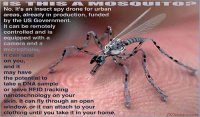You are using an out of date browser. It may not display this or other websites correctly.
You should upgrade or use an alternative browser.
You should upgrade or use an alternative browser.
Dang Mosquito's
- Thread starter mAlice
- Start date
frogman123
New Member
Knowing these forums, 90% of the people on here are going to believe this.
Vince
......
If you say it's not real, then it must be.Knowing these forums, 90% of the people on here are going to believe this.
Freefaller
Active Member
What's next?
Next thing you know, we'll have to deal with "Tracker Jackers"
Next thing you know, we'll have to deal with "Tracker Jackers"
frogman123
New Member
If you say it's not real, then it must be.
*than
mAlice
professional daydreamer
*than
No.
dontknowwhy
New Member
*than
wrong. here. here's a first grade grammar lesson for ya...
Than is used to compare two things.
Ex: Emily is taller than Jon.
Then is used for time.
Ex: first she walked to the store, then she bought candy
published in the 1990's ...
"Working the bugs out of a new breed of 'insect' robots"
Genghis looks dead. He rests on a table in an MIT laboratory, all six legs outstretched. His metal body-a foot long and encrusted with wires and switches-is inert. But Genghis is merely dormant.
Researcher Colin Angle flicks a switch. Genghis straightens his legs and stands up. Eyelike infrared sensors in his "head" take in his surroundings. Pressure sensitive metal whiskers sticking out front come alive. Genghis scuttles across the table, making an insect like sound, thweep . . . thweep. His mission in life is to attack-he sits and waits for somebody to walk by, and then he chases them," Angle says.
Genghis' dedication to his mission can be disconcerting. "We had a young woman up here and she asked, What happens if he gets the person?"' Angle says. He grabs Genghis just before the robot thweep-thweeps over the table's edge. "The only way he actually could get you is if you fell asleep and waved your arms, because he's not fast and he needs the motion of a warm body to see at all."
Genghis, the motion-seeking robot (pp. 72 -73), was created by the Mobile Robot Project at the Massachusetts Institute of Technology, which is busily inventing a robot menagerie. So far the creations of the Artificial Insect Lab, as they've come to call it, range from Seymour, who has been known to peddle candy, to a tiny electronic cockroach named Squirt, who mostly hides in the dark, under chairs.
It is not by chance that the lab's researchers give their silicon-and-wire proteges names, as if they were living creatures: it is the lab's self-assigned mission to create robots with behaviors so lifelike they are indistinguishable from the behaviors of real chitin-and-blood arthropods. To do that, they have dreamed up a new way of building robots. While the typical industrial robot might be a backhoe's brother, the lab's creations are small and buglike. And, while most robot designers try to give their creations a degree of artificial intelligence, the Insect Lab's minirobots operate on a far simpler principle.
Genghis has no brain. At least, unlike the average robot, he has no central computer that tries to mimic high levels of human thinking. A conventional robot's electronic brain takes in impressions of the world from sensors and mulls the data-creating an internal model of its environment. It then issues appropriate orders to the motors controlling its legs or other appendages. Genghis does without such a model of his surroundings. Each of Genghis' legs marches to its own siliconchip drummer, responding to rules, or behaviors," as simple as, "If I'm a leg, and I'm up, put myself down" or "Avoid obstacles." Yet, from the anarchy emerges coherent behavior: Genghis fixates on anything that moves, and attacks. If a rock is in his path, he steps over it. Plop a barrier in front of his "face" and he walks around it. A tiny microprocessor takes the place of a central computer, so Genghis is, almost literally, flea brained. Still, he may sire an intellectual revolution.

